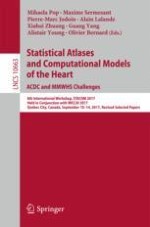This book constitutes the thoroughly refereed post-workshop proceedings of the 8th International Workshop on Statistical Atlases and Computational Models of the Heart: ACDC and MMWHS Challenges 2017, held in conjunction with MICCAI 2017, in Quebec, Canada, in September 2017. The 27 revised full workshop papers were carefully reviewed and selected from 35 submissions. The papers cover a wide range of topics computational imaging and modelling of the heart, as well as statistical cardiac atlases. The topics of the workshop included: cardiac imaging and image processing, atlas construction, statistical modelling of cardiac function across different patient populations, cardiac computational physiology, model customization, atlas based functional analysis, ontological schemata for data and results, integrated functional and structural analyses, as well as the pre-clinical and clinical applicability of these methods. Besides regular contributing papers, additional efforts of STACOM workshop were also focused on two challenges: ACDC and MM-WHS.
